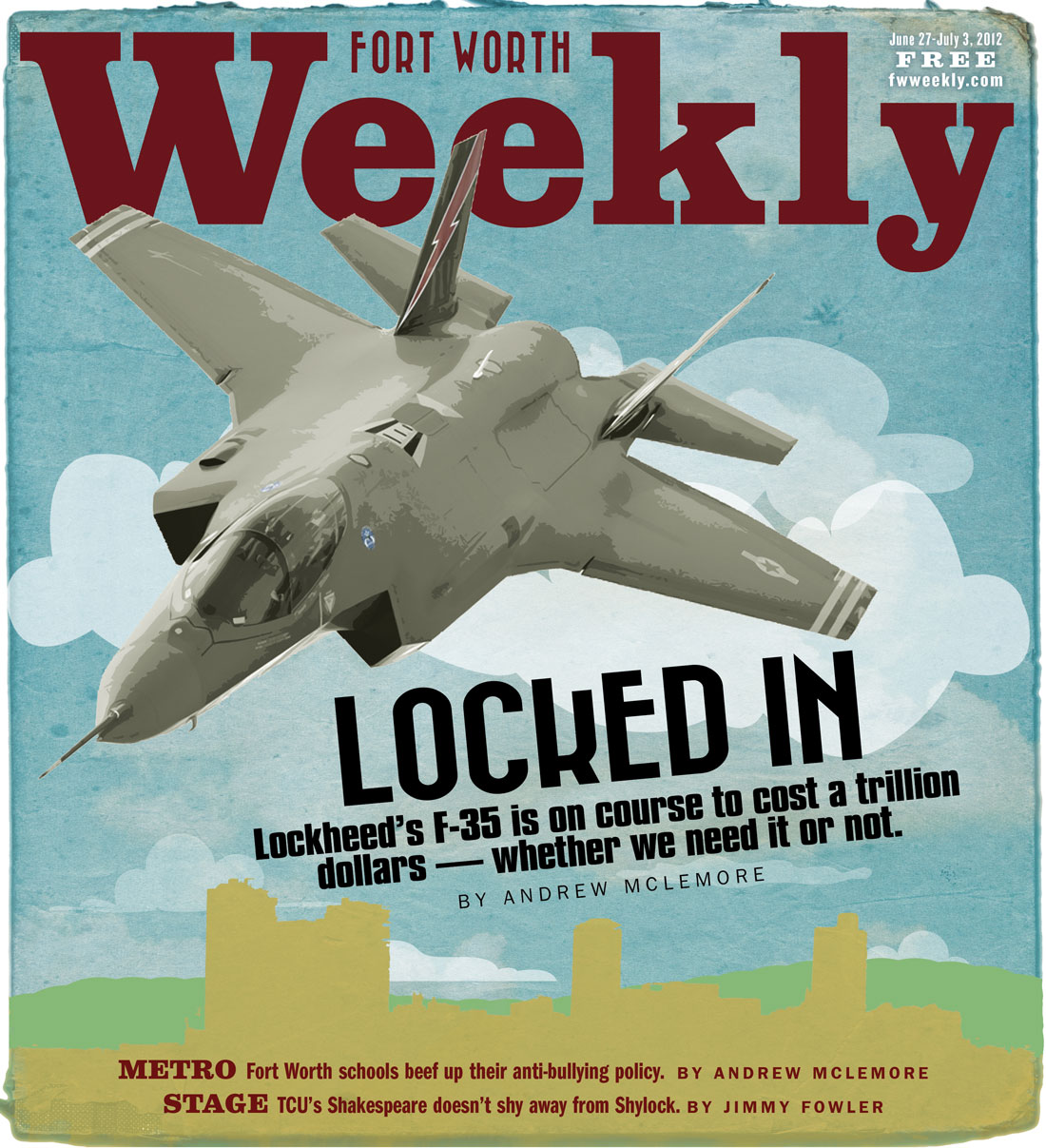The bold red letters –– ON STRIKE –– etched themselves into the dull grays of an overcast morning.
The 20 striking employees of Lockheed Martin marched mostly in silence across Lockheed Boulevard, crossing each time the light turned red and lifting their signs high against the sky. Looming above them was the signature cobalt blue of the corporation’s entranceway, a massive arch and tailfin emerging from the ground like the shiny skeleton of some long-buried airplane.
It was Week 8 in the strike by 3,300 unionized workers against the giant defense company. The union opposed the company’s plans to stop offering traditional pension plans to new workers.
Striking worker Tootie Boyd watched a pint-sized Smart car drive into the Fort Worth manufacturing plant where many of the strikers have worked for decades. “We could have bought one of those by now,” said Boyd, referring to the two months of striking and no paychecks.
Lockheed workers may not be able to afford tiny cars, and perhaps Lockheed indeed cannot afford traditional pension plans for its workers. After two months, the two sides reached an agreement June 23, though the details haven’t been announced yet.
Regardless, it’s been an odd fight, played out in the context of the most expensive weapons program in history, where each plane may end up costing as much as $200 million, and the full program is likely to cost more than twice what the United States government spent last year on Social Security benefits.
The F-35 Joint Strike Fighter is the Fort Worth plant’s primary product. It’s a weapons program that critics believe is poorly thought out and largely unnecessary for the continued air supremacy of the American military. Opponents say the F-35 is sucking up so much of the federal budget that it’s making it even more likely that Congress will decide to ax spending on things like food stamps, children’s healthcare, and Medicaid, just to pay the Pentagon’s bill.
With the F-35, for the first time, three branches of the U.S. military are placing their fighter-plane eggs in one basket. If there are problems with the F-35’s performance in the future, the Navy, Marines, and Air Force will all feel the effects. What’s more, some military critics say it’s the wrong plane for fighting the likely wars of the future.
U.S. Rep. Todd Akin, a Missouri Republican, is one of several members of Congress questioning why, after 20 years of aircraft development, there is still no solid date for widespread deployment. Many aspects of development remain “behind schedule and risky,” requiring unprecedented annual payouts of $13 billion through at least 2035, according to a March report from the U.S. Government Accountability Office. This country and others have cut back their orders of the plane.
The U.S. Senate Armed Services Committee said in a report that it is “concerned about production quality and whether it is sufficient to ensure the delivery of JSF aircraft to the U.S. and its allies at an affordable price.”
The already-massive costs of the program have nearly doubled in the last decade, and Lockheed is under the gun to show that it is saving money somewhere. Ergo, the tightening of workers’ benefits.
[pullquote_right]Should Congress cut food stamps or the F-35?[/pullquote_right]“The contract offered to the union reflects the realities of the defense business today: that we’ve got to reduce our costs,” company spokesman Joe Stout said.
But here’s a broader reality: Despite the increasing criticism, pressure from the military and Congress, and continuing problems with the plane, the chances are slim that the program will be stopped or even significantly cut back. With billions of dollars already spent on the project and Lockheed spending millions more on lobbying Congress, the plane may have reached an unstoppable momentum.
If you ask Lockheed, things are going swimmingly.
“We are addressing issues and applying them as we continue to move forward,” said another company spokeswoman, Laurie Quincy, adding that the F-35 is the most complex fighter plane ever built. “Nothing like this has ever been done before.”
Whatever the program’s price tag, politicians –– and therefore taxpayers –– will end up paying it, said Chris Hellman of the National Priorities Project, a nonprofit research organization focused on the federal budget. Lockheed, the world’s largest defense contractor, effectively has a monopoly on production of the fighter jet, so the company will likely be flush with cash for decades to come, he said.
U.S. military spending is “a broken system,” and the F-35 has become the best example of it, Hellman said. “There’s no accountability for doing a crappy job. … It begs the larger question of why we can’t develop and buy affordable weapons in this country. That’s what the story of the Joint Strike Fighter is really about.”
********
The F-35 was conceived to meet lofty expectations.
The various military services require different things from their warplanes: Navy fighters must take off from the dangerously short runways of aircraft carriers and withstand salty, corrosive ocean air, while the Marines need planes that can reach remote areas with vertical take-offs and landings.
Thus far, each service uses entirely different planes.
Lockheed was supposed to change all that with the F-35 by building three variants of the same jet, replacing nearly every tactical warplane in the armed forces. The idea was that each service would get a new stealth fighter, but the Pentagon would save money because it was the same company and core design for all of them.
It hasn’t worked out that way.
“They thought they could do better than what reality has shown to be the case,” Hellman said. As the F-35 program progressed, the needs of the services diverged, requiring greater development of each variant. “We call it the Christmas tree effect. You develop a program, and then you start hanging all these ornaments on it.”
Many of the plane’s proponents say it’s the next F-16, which was produced in the same Fort Worth plant in the 1970s and is now widely considered the best fighter jet ever built.
Early on, the F-16 program had its critics and cost overruns. In the end it all worked out, and the F-35 will be no different, said Loren Thompson, a founder of the pro-defense nonprofit Lexington Institute and a consultant for Lockheed Martin.
As Lockheed builds more planes, the process will become more efficient and the price will come down.
“That’s where we are now,” Quincy said. “We are improving on the learning curve and reducing costs on the jet through the production.”
William Astore, a retired Air Force lieutenant colonel, believes differently.
The F-35 is far more ambitious and complicated than the F-16, he said. A closer analogy is the F-111, another “be-all, end-all fighter” that failed in the 1960s and ’70s to live up to the hype.
“I don’t think the F-35 is acutely needed,” Astore wrote in an e-mail. “Current aircraft such as the F-15E, F-16 variants, F-18 variants, and various Army helicopters, most notably the Apache, can and are doing the job.”













The U.S. military should retool with new aircraft, how about develop the new single-seat F-15F variant (based on the two-seat F-15E) to replace the F-15C/Ds, in a similar way the Sukhoi Co. developed the Su-35S Super Flanker-E.
With new updates for the Eagle such as.
1. APG-82 AESA fire control radar.
2. 2D or 3D thrust vectoring F100-PW-232 or F110-GE-132 engines with supercruising mode as a consideration.
3. DEWS (Digital Electronic Warfare System) or defensible EWSP jammers.
4. NG (Next Generation) 3-D touch screen cockpit display.
5. Digital fly-by-wire flight control system.
6. IRST sensor pod and CFB (Conformal Weapons Bay) etc.
One of the F-15 engineers from the DoD Buzz mentioned the samething about develop the new single-seat Eagle as a perfect replacement for the existing F-15C/D’s.
So they are some of the options that can be looked at.
According to Richard Banholzer, Boeing’s Director of Business Development for the Air Force Fighters and Weapons, was a former USAF F-15A, F-15C and F-15E pilot and test pilot, with 2,000 hours on the F-4 Phantom II and 1,900 hours on F-15s.
He claims the F-15 still has a vital role to play (which I agree). The F-22 Raptor, with their greater stealth, Raptors might be the aircraft of choice to penetrate particularly high-threat zones.
However, on the “friendly” side or low to medium threat zones of the forward edge of the battle area – for cruise missile defence, defending high value assets and if the rules of engagement dictate close-in-engagement – the F-15 may be a better choice. So a mixed force of Eagles and Raptors would present a potent combination of flexibility and capability which is a perfect idea to complement with each other.
Plus restart the F-22 production line.
The F-35 Joint Strike Failure is certainly not a true 5th Generation Fighter, the aircraft is a boondoggle. It’s now time to throw the turkey in the trash bin and see the rotten damn thing in the fire and burn for good.
The United States is making a gigantic investment in the F-35, billed by its advocates as the next — by their count the fifth — generation of air-to-air and air-to-ground combat aircraft. Claimed to be near invisible to radar and able to dominate any future battlefield, the F-35 will replace most of the air-combat aircraft in the inventories of the U.S. Air Force, Navy, Marine Corps, and at least nine foreign allies, and it will be in those inventories for the next 55 years. It’s no secret, however, that the program — the most expensive in American history — is a calamity.
This month, we learned that the Pentagon has increased the price tag for the F-35 by another $289 million — just the latest in a long string of cost increases — and that the program is expected to account for a whopping 38 percent of Pentagon procurement for defence programs, assuming its cost will grow no more. Its many problems are acknowledged by its listing in proposals for Pentagon spending reductions by leaders from across the political spectrum, including Rep. Barney Frank (D-Mass.), Sen. Tom Coburn (R-Okla.), President Barack Obama’s National Commission on Fiscal Responsibility and Reform, and budget gurus such as former Sen. Pete Domenici (R-N.M.) and Alice Rivlin, former director of the Congressional Budget Office and Office of Management and Budget.
How bad is it? A review of the F-35′s cost, schedule, and performance — three essential measures of any Pentagon program — shows the problems are fundamental and still growing.
First, with regard to cost — a particularly important factor in what politicians keep saying is an austere defence budget environment — the F-35 is simply unaffordable. Although the plane was originally billed as a low-cost solution, major cost increases have plagued the program throughout the last decade. Last year, Pentagon leadership told Congress the acquisition price had increased another 16 percent, from $328.3 billion to $379.4 billion for the 2,457 aircraft to be bought. Not to worry, however — they pledged to finally reverse the growth.
The result? This February, the price increased another 4 percent to $395.7 billion and then even further in April. Don’t expect the cost overruns to end there: The test program is only 20 percent complete, the Government Accountability Office has reported, and the toughest tests are yet to come. Overall, the program’s cost has grown 75 percent from its original 2001 estimate of $226.5 billion — and that was for a larger buy of 2,866 aircraft.
Hundreds of F-35s will be built before 2019, when initial testing is complete. The additional cost to engineer modifications to fix the inevitable deficiencies that will be uncovered is unknown, but it is sure to exceed the $534 million already known from tests so far. The total program unit cost for each individual F-35, now at $161 million, is only a temporary plateau. Expect yet another increase in early 2013, when a new round of budget restrictions is sure to hit the Pentagon, and the F-35 will take more hits in the form of reducing the numbers to be bought, thereby increasing the unit cost of each plane.
A final note on expense: The F-35 will actually cost multiples of the $395.7 billion cited above. That is the current estimate only to acquire it, not the full life-cycle cost to operate it. The current appraisal for operations and support is $1.1 trillion — making for a grand total of $1.5 trillion, or more than the annual GDP of Spain. And that estimate is wildly optimistic: It assumes the F-35 will only be 42 percent more expensive to operate than an F-16, but the F-35 is much more complex. The only other “fifth generation” aircraft, the F-22 from the same manufacturer, is in some respects less complex than the F-35, but in 2010, it cost 300 percent more to operate per hour than the F-16. To be very conservative, expect the F-35 to be twice the operating and support cost of the F-16. Already unaffordable, the F-35′s price is headed in one direction — due north.
The F-35 isn’t only expensive — it’s way behind schedule. The first plan was to have an initial batch of F-35s available for combat in 2010. Then first deployment was to be 2012. More recently, the military services have said the deployment date is “to be determined.” A new target date of 2019 has been informally suggested in testimony — almost 10 years late.
If the F-35′s performance were spectacular, it might be worth the cost and wait. But it is not. Even if the aircraft lived up to its original specifications — and it will not — it would be a huge disappointment. The reason it is such a mediocrity also explains why it is unaffordable and, for years to come, unobtainable.
In discussing the F-35 with aviation and acquisition experts — some responsible for highly successful aircraft such as the F-16 and the A-10, and others with decades of experience inside the Pentagon and years of direct observation of the F-35′s early history — I learned that the F-35′s problems are built into its very DNA.
The design was born in the late 1980s in the Defence Advanced Research Projects Agency (DARPA), the Pentagon agency that has earned an undeserved reputation for astute innovation. It emerged as a proposal for a very short take-off and vertical-landing aircraft (known as “STOVL”) that would also be supersonic. This required an airframe design that — simultaneously — wanted to be short, even stumpy, and single-engine (STOVL), and also sleek, long, and with lots of excess power, usually with twin engines.
President Bill Clinton’s Pentagon bogged down the already compromised design concept further by adding the requirement that it should be a multirole aircraft — both an air-to-air fighter and a bomber. This required more difficult trade-offs between agility and low weight, and the characteristics of an airframe optimised to carry heavy loads. Clinton-era officials also layered on “stealth,” imposing additional aerodynamic shape requirements and maintenance-intensive skin coatings to reduce radar reflections. They also added two separate weapons bays, which increase permanent weight and drag, to hide onboard missiles and bombs from radars. On top of all that, they made it multi-service, requiring still more trade-offs to accommodate more differing, but exacting, needs of the Air Force, Marine Corps, and Navy.
Finally, again during the Clinton administration, the advocates composed a highly “concurrent” acquisition strategy. That meant hundreds of copies of the F-35 would be produced, and the financial and political commitments would be made, before the test results showed just what was being bought.
This grotesquely unpromising plan has already resulted in multitudes of problems — and 80 percent of the flight testing remains. A virtual flying piano, the F-35 lacks the F-15′s and F-16′s agility in the air-to-air mode and the F-111 and F-15E’s range and payload in the bombing mode, and it can’t even begin to compare to the A-10 at low-altitude close air support for troops engaged in combat. Worse yet, it won’t be able to get into the air as often to perform any mission — or just as importantly, to train pilots — because its complexity prolongs maintenance and limits availability. The aircraft most like the F-35, the F-22, was able to get into the air on average for only 15 hours per month in 2010 when it was fully operational. (In 2011, the F-22 was grounded for almost five months and flew even less.)
This mediocrity is not overcome by the F-35′s “fifth-generation” characteristics, the most prominent of which is its “stealth.” Despite what many believe, “stealth” is not invisibility to radar; it is limited-detection ranges against some radar types at some angles. Put another way, certain radars, some of them quite antiquated, can see “stealthy” aircraft at quite long ranges, and even the susceptible radars can see the F-35 at certain angles. The ultimate demonstration of this shortcoming occurred in the 1999 Kosovo war, when 1960s vintage Soviet radar and missile equipment shot down a “stealthy” F-117 bomber and severely damaged a second.
The back end of the F-35 in full afterburner is something like 1600 degrees (Fahrenheit). In terms of temperature, aluminium combusts at 1100. You are talking about something really, really hot. If you have got a dirty big sensor on the front of your Su-35 or your PAK-FA or whatever, it lights up like Christmas lights and there is nothing you can do about it. And the plume, because of the symmetric exhaust, is all over the place. It is not shielded, it is not ducted in any useful way.
I’m all familiar with these effusive comments that I see in the media about how wonderful the JSF is—it is a stealth fighter; it is invisible to enemy radar—but the reality is that stealth is not as much about invisibility but much more about being harder to detect than an ordinary aeroplane.
The typical measures that are applied are: what radars are you stealthy against and from what direction are you stealthy against that radar? There are various models, analogies or explanations that are used, but I think the simplest one is that different radars, because of how they are built, need different stealth characteristics to beat them. If we look at the current range of stealth aircraft out there, the ones that are difficult to see from nearly all directions and by a wide range of radars, are the big B-2A Spirit and the F-22 Raptor. The JSF really only has performance that would qualify as stealthy in the direction of over the aircraft’s nose. In other words, it is hard to see from the front but if you look at the aircraft from the sides or behind and below—looking up at it—the aircraft is in many instances only marginally better than a conventional aircraft.
The 55Zh6M Nebo M. It is a multi-band “counter-stealth radar”. The VHF band element in that radar will detect the F-35A at a distance of tens of miles. That is without a doubt. What that means is that the aircraft is going to be in great difficulty if it tries to deal with what I call a modern or contemporary threat. The same is also true when you deal with these newer stealth fighters, because they are designed to compete with the F-22. They fly higher; they are faster and more agile—much, much more agile. They have more powerful radars and much, much better antenna packages for other sensors. The lemon F-35 is not meeting its specifications and its specifications are inadequate to deal with the changed environment.
But if you are putting F-35 up against the newer generation of much, much more powerful Russian radars and some of the newer Chinese radars, the aircraft is quite detectable, especially from behind, the upper side and from the lower sides as well.
The bottom line: The F-35 is not the wonder its advocates claim. It is a gigantic performance disappointment, and in some respects a step backward. The problems, integral to the design, cannot be fixed without starting from a clean sheet of paper.
It’s time for Defence Secretary Leon Panetta, the U.S. military services, the Congress and pro-JSF advocates: The F-35 is an unaffordable mediocrity, and the program will not be fixed by any combination of hardware tweaks or cost-control projects. There is only one thing to do with the F-35: Junk it. America’s air forces deserve a much better aircraft, and the taxpayers deserve a much cheaper one. The dustbin awaits.
PS The US, the allies including Australia don’t need the F-35. The aircraft is a absolute complete failure and will be useless in the future conflicts.
For more information go to the Air Power Australia.
Loren Thompson
If the F-35 was to be able to meet its specifications, the aircraft will have the ability of going up against a 1980s Soviet air defence system of the type that we saw destroyed very effectively in Libya 12 months ago, the F-35 would be reasonably be effective in that environment, because these older Soviet radars would not see it. Now the environment has changed the Russians and some of the Chinese are equipped with much more powerful “counter stealth radars” to able to detect the F-35, especially from behind, the upper side and from the lower sides as well, which is why the F-35 has “partial stealth”.
Plus the F-35 is also inferior to the Sukhoi Su-27/30 Flanker family, PAK-FA and J-20 Mighty Dragon aircraft in Beyond Visual Range and Within Visual Range combat etc.
The requirement for the F-35 is only Mach 1.6 you won’t be able to survive because you’ll be placed at a significant disadvantage to Mach 2.4 aircraft such as the super cruising Sukhoi and upcoming J-20. The wing and engine intake geometry is optimised for sub-sonic flight – so a more powerful engine cannot fix the problem even if one would fit in the small JSF airframe. In stealth combat configuration, the F-35 aerodynamically doesn’t and will never be able to outperform all other combat-configured 4th, 4.5, 4++ and 5th generation aircraft in top-end supersonic acceleration, loiter, combat radius, larger weapons payload and more powerful/bigger AESA fire control radar/sensors. This doesn’t allow unprecedented see/shoot first and combat radius advantages.
The situation by relying only on stealth, AESA radar, advanced sensors, networking, data fusion capabilities, BVR AAMs and cruise missiles as stand-off while flying at straight and level with very gentle manoeuvres of presents of guns or missiles the JSF will be a “dead duck”. It doesn’t work that way which again you’ll be placed at a significant disadvantage of being shot down while being chased by a Mach 2 Sukhoi and J-20 that the F/A-18E/F and F-35 can’t escape. Even though fighters are rarely used at mach 2 for air-to-air combat or ground attack, but I still believe it is still needed for survivability because it enhances both engagements of flying into the target area and destroying the high threat targets, and escape from, known threats as to get out of the fight as quick as possible to survive.
This is not the first time the Defense Dept. has tried to build a one size fits all fighter. Back in the early 1960’s, there was the F111. It was plagued with problems and cost overruns & it was also built in Ft. Worth by General Dynamics at the time. Eventually, only the Air Force used the plane.